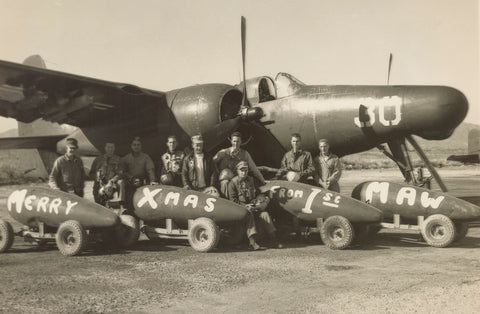
Merry Christmas in Korea
Personnel of the 1st Marine Aircraft Wing display a special Christmas message in December 1950 during the Korean War. It was their “Yuletide gift to Korean and Chinese Reds,” they said. The Marines pictured, all from Ohio, are (left to right) M/Sgt. Robert T. Hunt, 1st Lt. David W. Bowman, M/Sgt. Thomas H. Allom, Lt. Arnold J. Hammons, Lt. Walter J. Waldo, Capt. Leland A. Gaug, Capt. William G. Diar Jr., M/Sgt. William R. Goodall III and Maj. George A. Hanna. Their airplane is a Grumman F7F-3N Tigercat.
The Grumman Tigercat first flew in 1943 but it arrived too late for a combat role in World War II. The Marine Corps ordered 500 of the carrier-based, twin- engine airplanes but used the Tigercat for land-based missions in Korea. Two variants, the -3N and -4N, were modified specifically for a nightfighting role, with an extended nose that housed radar equipment.
Two Marine squadrons flew Tigercats in Korea. The first was VMF(N)-542, which was relieved by VMF(N)-513, a unit that called itself the “Flying Nightmares.” According to a history of Marine Corps Aviation in Korea, “The Flying Nightmares soon found their specialty in night interdiction, flying against Communist road supply traffic, much as their successors would do more than 10 years later and farther south in Vietnam, this time flying F-4 Phantoms.”
In Korea, the Nightmares also scored two kills with Tigercats, both of them Soviet-built Polikarpov Po-2s. Although the Po-2 was a wood-and-fabric biplane, North Korea used them extensively in the early years of the war for nighttime ground attacks. Its low speed could actually be an asset: in 1953 a Lockheed F-94 Starfire stalled and crashed when the pilot throttled back too much in an engagement with a Po-2.
historynet magazines
Our 9 best-selling history titles feature in-depth storytelling and iconic imagery to engage and inform on the people, the wars, and the events that shaped America and the world.
